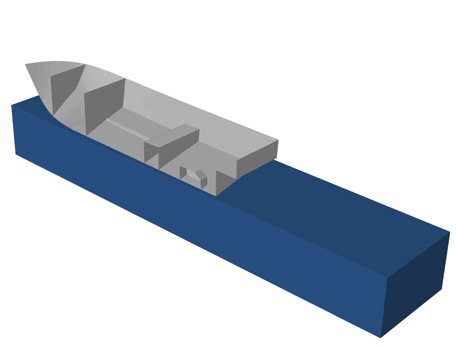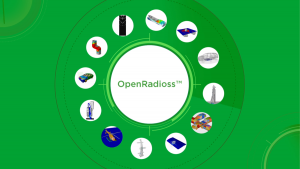How Altair and Ansys compare to traditional open-source CAE like OpenFOAM. Earlier this year, Altair announced that its finite element dynamic simulation tool, Radioss, will have an open-source version available to users called OpenRadioss.
The goal of this open-source release from the Troy, Mich. simulation software company is to jumpstart the pace of innovation in the engineering community. Releasing the code as open source is one way that Altair feels it can bring together the industry, academic and research communities that already use the software and find new ways to use the tool.

OpenRadioss will help users make fluid structure multiphysics decisions. (Image courtesy of Altair.)
The motivation here is to advance the societal impact that Radioss can have by shifting the tools to OpenRadioss. Through a selfish lens, Altair can hope to gain more users as engineers and programmers jump on this useful tool, which is now available as a free offering. Viewing it less cynically, this is a tool used in the engineering and design of aerospace, railways, electronics and automotive applications. Users of all organizational sizes in these industries now have free access. In other words, the potential for technological advances is huge.
Radioss has helped engineers make decisions about dynamic simulation events for more than 30 years. This addition of an open-source version of the tool should help even more engineers adopt the software and implement the tools into the design and development process.
However, past releases of open-source simulation tools have led engineers to debate the true definition of open-source and free-use tools. So now that the dust has settled a bit, let’s look into the overall open-source trend through the eyes of the OpenRadioss release.
How Open-Source Are We Talking Here?
Altair’s Chief Engineer Ming Zhou answered a few questions about the decision to release OpenRadioss. He said to engineering.com that one of the main differences between Altair Radioss and OpenRadioss moving forward will be the release schedule. OpenRadioss will see “a stable but constantly evolving code base to keep a highly active research community engaged.” This is a great way to pull in academic researchers who might be heavily into coding and be working in a tight timeframe. Instead of waiting for the traditional two or three software updates that happen each year with commercial Altair projects, these researchers can work through the code and modify or add a feature that applies to one specific grant or study. And the beauty of the open-source model is that everyone can benefit from this new feature added to the software.
The essence of open source can be controversial or, at least, open to debate. Some people think that the term means a software tool, application or game is completely free. Even going directly to the source can be difficult because you’re faced with the choice to use opensource.com or opensource.org—the former being a hub of tutorials, stories and resources and the former being focused on community-building, education and public advocacy. Choosing the familiar green icon from the opensource.org option, there’s a full open-source definition. The basics say that “Open-source software is software that can be freely accessed, used, changed and shared (in modified or unmodified form) by anyone.”
This doesn’t mean that the software cannot be owned by a corporation or even that the corporation cannot have its own version where customers pay to use the tool. Users might even need to pay to use that version of the software or tool. The classification says that the underlying code can be accessed and modified by a user.
Is Open-Source Simulation a New Idea?
OpenFOAM is the open-source simulation tool that I am most familiar with in terms of widespread use. The computational fluid dynamics (CFD) software has a moderately corporate feel to it. New releases come out every six months, and the parent company, OpenCFD, offers training to new users and a service where its engineers can take on customer projects. There are plenty of avenues for OpenCFD to earn money from this tool, even though it can be downloaded without cost.

Model of bird vs aircraft wing shows dynamic interactions (Image courtesy of Altair.)
Ansys has also released PyAnsys as a group of open-source Python scripts for use with Ansys products. These tools began a debate in the engineering and simulation community about what really constitutes open-source tools and how much benefit comes from having source code available to anyone. This release approach took a hit in the court of public opinion because the PyAnsys scripts were useful for simulation engineers, but the usefulness required the purchase of the base Ansys software to make full use of the open-source tools. This approach is much different and presumably much more open to criticisms from the user base than Altair releasing a free and core code-accessible version of its tool.
Engineering simulation software tools that are free for public consumption are not a new thing. Many of us in undergrad can recall a professor who made the use of his or her proprietary software mandatory for a project. My experience was with a heat transfer professor who was sure that his heat flow tool would revolutionize the industry but could not find a corporate sponsor or licensor. Even now in the halls of academia or a research center, if you spend a few hours talking to colleagues, you can find someone who developed a simulation or CNC or system design tool as part of a master’s thesis or doctoral dissertation but never spent the time required to develop and commercialize the tool.
What Does It All Mean?
One of the biggest factors here for me is Altair’s stated motivation behind this open-source offering. In the release video, a few big points are made. The first is that Altair feels like technology should be advancing faster. The second huge idea comes from James Scapa, Altair founder, when he says, “For us, the purpose of Altair, in general, is really just to advance humanity.”
This idea came through from Zhou as well when I asked what benefit Altair would see from releasing OpenRadioss. He said, “When the impact of the technology grows, all the entities, including Altair, will benefit from increased research and business opportunities.” When the world wins, we win as engineers who are citizens of the world.
This is a major and welcome shift from the big business ideas of corporate profits and market shares. Technology’s relationship with humanity grows more complicated every year, and we’ve come a long way from the early 2000 Google motto “Don’t Be Evil.” As technology users, we worry about how much privacy we have while banking, internet scrolling and using simulation. There’s an underlying idea that if the product is free to use, then users and their data are the product. Altair may have some motive to see what users will do with the OpenRadioss tool and what projects are being simulated, but this was already information that could be obtained from the commercial Radioss versions.
At this point in OpenRadioss history, anything is possible. We’re sitting at the point where everything is potential innovation and nothing has been exhausted to the kinetic side yet. Engineers and programmers might find ways to make the code more efficient, faster to run and with fewer resources required, or build more fidelity into the results. When the tool is boosted to new levels, technology can reap the benefits. Consumer electronics can be stronger and less susceptible to drop damage while aircraft and automobiles can become safer to operate.
The goal of simulation is always to help engineers make solid decisions quickly and early in the design and development process with a strong degree of fidelity and confidence in the results. Altair recognizing that all industries are at least partially responsible for solving the issues of climate change and sustainability is a great push toward using engineering and simulation to make the world a better place. Making the source code of Radioss available to users to dissect, modify and improve is a pragmatic and altruistic move. Taken at face value, it’s inspiring to see Altair effectively telling the simulation world “You’re doing great things with our software, and we’d love to see you come together and do even more.”

